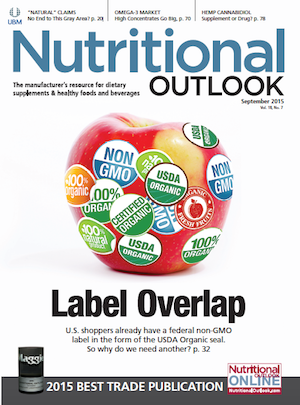Non-GMO Riding on Organic’s Coattails?
Do non-GMO labels benefit from consumers’ inability to distinguish between organic and non-GMO?

It’s no secret that the food industry teeters on label overload. U.S. food consumers who want to make socially conscious choices today must wade through numerous packaging claims and certification seals. Eager to join these is the Safe and Accurate Food Labeling Act’s (SAFE; H.R. 1599) proposed voluntary federal seal for non–genetically modified organisms (GMOs). Passed by the House of Representatives in July, SAFE is now in the hands of the Senate.
In a separate article, I discuss potential overlap between SAFE and the USDA’s National Organic Program (NOP) and other non-GMO certification seals already on the market. I also question whether SAFE would increase consumer confusion.
Is there so much clutter that we’ve essentially rendered these seals meaningless to the everyday consumer? Sadly, the answer is that, regardless of SAFE or any other GMO-labeling law, consumers are already confused about GMOs to begin with.
In June, the Hartman Group estimated that just over half of the U.S. population understands what a GMO is. Not only that, but a mere 9% of consumers knows that certified-organic food is inherently non-GMO.[1]
The general consensus is that more outreach would help educate consumers about what organic is, what non-GMO is, and what their regulations mean. Gwendolyn Wyard, senior director of technical and regulatory affairs for the Organic Trade Association (OTA; Washington, DC), believes that, in general, consumers are aware that USDA Organic certification excludes GMOs. Still, she agrees, “more education is needed.” A USDA spokesperson calls the agency “committed to ensuring consumers understand the USDA organic label and its requirements.”
The USDA Organic label, after all, has a lot to be proud of, banning both pesticides and GMOs-something that most GMO-certification programs do not. Put another way, “Organic is by definition non-GMO, but non-GMO may or may not be organic,” says David Carter, CEO of FoodChain ID (Fairfield, IA).
“Whereas organic addresses a wide range of issues, including use of pesticides, synthetic chemicals, antibiotics, hormones, sustainable agronomic practices, etc.,” Carter says, “non-GMO addresses a single aspect of food and agricultural production.”
For what it’s worth, at least one person suggests that non-GMO labels might actually benefit from consumers’ inability to distinguish between organic and non-GMO. In a February story titled, “Why the ‘Non-GMO’ Label Is Organic’s Frenemy,”[2] NPR food and agriculture correspondent Dan Charles quoted the Cornucopia Institute’s cofounder Mark Kastel as describing non-GMO labels as “a potent marketing vehicle designed to blur the line between organic and nonorganic.” In short, Charles wrote that some food marketers see non-GMO as a less-expensive certification that delivers the same benefits as organic certification in the minds of consumers who don’t know the difference.
One organic certifier is trying to highlight the difference. California Certified Organic Farmers (CCOF) rolled out a new certification seal this March to educate consumers on organic’s benefits in relation to non-GMO. As reported by NPR writer Peggy Lowe in August,[3] CCOF calls its new seal “Organic Is Non-GMO & More.” According to CCOF, this seal “underscores the prohibition of GMOs in organic and recognizes the many contributions of organic to a healthier world.” In a March 2015 press release [4] announcing the new seal, Philip LaRocca, chairman of CCOF Inc., stated, “CCOF firmly believes that organic is the champion of non-GMO” because it provides assurance not just of non-GMO but also for “enhancing soil health and biodiversity, supporting animal welfare, and providing traceability of products produced without synthetic fertilizers or persistent pesticides.”
If leveraged effectively, food-certification seals are extremely valuable-for both education and marketing. If successful, they provide consumers with meaningful and easily understandable information about what’s in their food. If not, the situation clouds, and it’s the consumer seeking truthful information who suffers at the end of the day.
As the organic industry observes the skyrocketing success that the non-GMO industry is enjoying, it will become even more important for organic proponents to not only stand up for USDA Organic certification but also to teach consumers about what the seal really means.
Also read:
Would the Safe and Accurate Food Labeling Act's Non-GMO Label Overlap with USDA's Organic Seal?
Disclosures:
[1] “GMOs: The Elephant that Won’t Leave the Room,” http://hartbeat.hartman-group.com/article/604/GMOs-The-Elephant-That-Won-t-Leave-The-Room.
[2] Dan Charles, “Why The ‘Non-GMO’ Label Is Organic’s Frenemy,” National Public Radio, http://www.npr.org/sections/thesalt/2014/02/28/283460420/why-the-non-gmo-label-is-organic-s-frenemy
[3] Peggy Lowe, “'GMO-Free' Is A Boon For Companies Chasing 'Health Halo' Profits, http://www.npr.org/sections/thesalt/2015/08/19/432774389/gmos-are-becoming-a-proxy-for-bigger-concerns-about-the-food-system
[4]http://www.ccof.org/press/new-ccof-certification-seal-highlights-non-gmo-status-organic-food

Prinova acquires Aplinova to further increase its footprint in Latin America
April 7th 2025Prinova has recently announced the acquisition of Brazilian ingredients distributor Aplinova, which is a provider of specialty ingredients for a range of market segments that include food, beverage, supplements, and personal care.

























